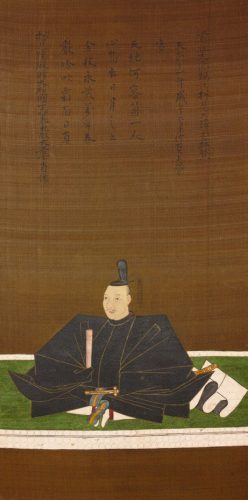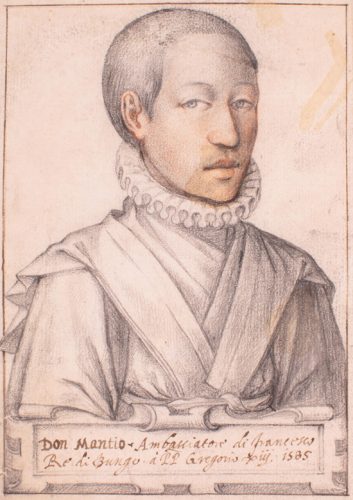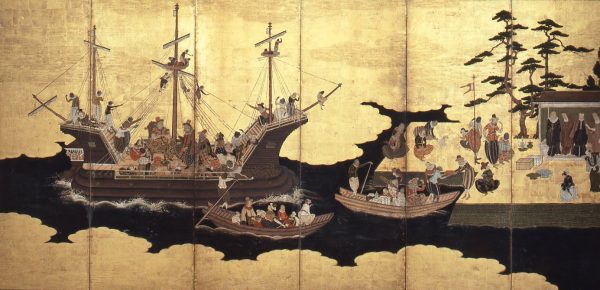Exhibitions
Nobunaga and Quattro Ragazzi: Hopes and Illusions of Momoyama Renaissance – Europe through the eyes of Hiroshi Sugimoto and the Tensho Embassy
2018.10.05(Fri) - 2018.11.04(Sun)
1st Anniversary of Museum Renovation Exhibition:

Overview
MOA Museum of Art underwent a total overhaul during 2016. The interior design was undertaken by the New Material Research Laboratory (NMRL), led by Hiroshi Sugimoto and Tomoyuki Sakakida, and the work was completed in February 2017. Later that year, Sugimoto held his exhibition “Hiroshi Sugimoto: Gates of Paradise” at the Japan Society in New York. To commemorate the reopening of the Museum, we are presenting this special exhibition entitled “Nobunaga and Quattro Ragazzi: Hopes and Illusions of Momoyama Renaissance,” introducing his “Gates of Paradise” first time in Japan. The Quattro Ragazzi, described in a book by the same title and written by a historian of European art, Midori Wakakuwa, refers to an emissary to the Pope in Rome dispatched in 1582, formed by four young Japanese men, also known as the Tensho Embassy.
The exhibition combines the “Hiroshi Sugimoto: Gates of Paradise” and artworks of the Momoyama period, notably those in relation to the Tensho Embassy, the Nanban art and Oda Nobunaga, a key figure in the wake of modern Japan. The exhibition showcases the exuberant art and culture that flourished during the Momoyama period.
◆Hiroshi Sugimoto Quattro Ragazzi
Nobunaga and the Dawn of Modern Society in Japan
In 1543, some Portuguese arrived on the shore of Tanegashima island - an incident that heralded the rise of modern culture in Japan. It is here that European firearms were first introduced to Japan. Oda Nobunaga (1534-1582: Fig. 1 below) seized the opportunity to incorporate this new weapon into his strategies for unifying the country. Nobunaga lived in the time when the Christian faith and European culture, brought by Jesuit missionaries to Japan, met the fascination of the nation.
Nobunaga did not quite accomplish the unification of Japan as he fell victim of a coup d’état that took place in the Honnoji temple in 1582. It was a little earlier in February of the same year that three Christian daimyōs in the Kyushu region dispatched four young Japanese to Europe, hoping to make a papal audience in Rome. The four boys witnessed the latter days of the Renaissance in Europe, and eight years later they returned to Japan, where the anti-Christian policy was enforced in full swing. However, the knowledge they brought back from Europe had an immense impact on Japanese culture thereafter.

1. Portrait of Oda Nobunaga Inscription by Kokei Sochin Momoyama Period Dated 1583 (Tensho11)
Kobe City Museum
Important Cultural Property
Nobunaga and Art during the Momoyama Period
Oda Nobunaga was born in 1534 in the domain of Owari (present-day Aichi prefecture). As a young man, he stood out from the crowd and was known for his bizarre behavior, gaining a reputation as The Big Fool of Owari. In 1560, he joined the Battle of Okehazama and won the battle against Imagawa Yoshimoto. After the victory, he was on a fast track toward ruling the country and no one could stop him. In 1568, he took his seat in the imperial Kyoto. Immediately, some influential figures paid homage to him, notably a warlord Matsunaga Hisahide (1508-1577) and Sakai-based prosperous merchant Imai Sōkyū (1520-1593), who presented Tsukumo Kami Nasu tea canister (Fig. 3) and a tea leaf jar Matsushima. Nobunaga issued a decree in 1569 that all tea utensils of excellence found in the region to be brought to his acquisition, especially those of Chinese origin. Some outstanding pieces of the collection from this period are included in the exhibition: tea canisters Hatsuhana (Fig. 2) and Nitta Katatsuki, tea leaf jars Shoka (Fig. 4) and Kinka (Fig. 5), tea canister Seitaka Katatsuki (Fig. 6) and some paintings by Muqi Fachang such as “Returning Sails off a Distant Shore” (Fig. 7) and “Myna Bird” (Fig. 8).
Nobunaga decided to build his castle in Azuchi in 1576, which, according to his chronicle Shinchō Kōki, had a main keep of five stories above ground, with two extra levels buried inside the foundational mound. Main rooms were decorated with lavish mural paintings by Kano Eitoku and pillars were all in black lacquer finish. The top floor of the structure was painted with motifs of legendary Chinese emperors and sages while the lower floors were decorated with more religious and mythological themes, such as the teachings of Shakyamuni, the Queen Mother of the West, the three teachings of Confucianism, Taoism and Buddhism. While Azuchi castle’s mural paintings by Kano Eitoku no longer exist, the opulence of such paintings may be exemplified by his folding screens depicting flowers and birds (Fig. 9) and celebrated places near the Capital (Fig. 10). The History of Japan by Charlevoix, a French Jesuit who visited Japan during this period, contains a drawing of the Azuchi castle (Fig. 11).

2.Tea Caddy Katatsuki type, Known as Hatsuhana
China, Southern Song to Yuan dynasty, 13th-14th c.
Tokugawa Memorial Foundation
Important Cultural Property

3.Tea Caddy, nasu type, Known as Tsukumo Nasu
China, Southern Song to Yuan dynasty, 13th-14th c.
Seikado Bunko Art Museum
 4.Tea Leaf Jar, Known as Shoka
4.Tea Leaf Jar, Known as Shoka
China, Southern Song to Yuan dynasty, 13th-14th c.
Tokugawa Art Museum
Important Cultural Property
 5.The Leaf Jar, Known as Kinka
5.The Leaf Jar, Known as Kinka
China, Southern Song to Yuan dynasty, 13th-14th c.
Tokugawa Art Museum
 6.Tea Caddy
6.Tea Caddy
Katatsuki type, Known as Seitaka Katatsuki
China, Southern Song to Yuan dynasty, 13th-14th c.
Egawa Museum of Art
Important Art Object
 7.Returning Sails off a Distant Shore By Mu Qi (Mokkei)
7.Returning Sails off a Distant Shore By Mu Qi (Mokkei)
China, Southern Song dynasty, 13th c.
Kyoto National Museum
Important Cultural Property
 8.Mynab Bird
8.Mynab Bird
Attributed to Mu Qi(Mokkei)
China, Southern Song dynasty, 13th c.
Goto Museum (right)
MOA Museum of Art (left)
 9.Birds and Flowers
9.Birds and Flowers
By Kano Eitoku
Momoyama Period, 16 th c.

 10.Scenes of Amusement around Kyoto
10.Scenes of Amusement around Kyoto
By Kano Eitoku
Momoyama Period, 16 th c.

11.General History and Description of Japan
Written by Pierre Francois Xavier de Charlevoix
Paris, France Dated 1736
Kyushu National Museum
The Tensho Embassy
A Jesuit Francis Xavier (1506-1552: Fig. 12) arrived in Kagoshima in 1549 as a first Christian missionary to Japan. It was 30 years later that the evangelical work gained impetus when Alessandro Valignano (1539-1606) arrived in 1579 and reformed the mission in Japan. According to his Sumario de las cosas de Japon (1583), there were about 200 churches and 150,000 Christians in the country.
It was Valignano who organized an embassy to the Pope, sending young Mancio Ito (Fig. 13) as an official representative of a Christian-converted daimyō Ōtomo Sōrin, accompanied by Miguel Chijiwa, Julião Nakaura and Martinho Hara, who represented the Arima and Ōmura clans. They set out on the eight-year journey, aiming to inform the European society of the missionary progress in Japan and to obtain financial support.
After their departure from Nagasaki on February 20, 1582, the embassy made stops at Macau, Malacca and Goa before finally arriving in Lisbon in August 1584. The ambassadors were greeted with exceptional welcome by European Christendom, including King Philip II of Spain, who received them at his palace in Madrid as he would receive European nobles. The embassy reached Rome in March 1985 and met with Pope Gregory XIII (1502-1585). His successor Pope Sixtus V (1521-1590) made Mancio an honorary citizen of Rome. The embassy left Rome in May, and as they made a tour through Assisi, Loreto, Bologna, Ferrara and other towns in Italy, the news about this expedition from the Orient stirred enthusiastic curiosity of the Europeans, evident in the fact that, in 1585 alone, 48 publications were made about them (Fig. 14).
On their journey back to Japan, the party again stopped at Macau, arriving in 1588. In Japan, however, Christianity was banned by Toyotomi Hideyoshi, and in 1590 the party was only allowed to return as an ambassadorial expedition to India. The following year, the four noblemen had an audience with Hideyoshi, the ruler of the time. It is said that Hideyoshi had them play European musical instruments such as the harpsichord and the viola in front of him.
Thereafter, Mancio Ito continued to live as a Jesuit until he died of illness in 1612, while Miguel left the Society of Jesus and vanished. Martinho Hara was banished from Japan in 1614 and stayed active in Macau until his death in 1629. Julião Nakaura also continued preaching, but he was caught by the Tokugawa shogunate and died a martyr by torture in 1633.
 12.Portrait of St. Francisco Xavier
12.Portrait of St. Francisco Xavier
Edo Period, 17th c.
Kobe City Museum
Important Cultural Property
 13.Portrait of Ito Mancio
13.Portrait of Ito Mancio
Italy Dated 1585
Nagasaki Museum of History and Culture
The Nanban Art and Handicrafts
 14.Report on the Voyage of Japanese Princes to Rome
14.Report on the Voyage of Japanese Princes to Rome
Written by Paolo Meietto
Reggio, Italy Dated 1585
Tokyo National Museum
Important Cultural Property
The Nanban Art and Handicrafts
The most notable contribution of the Tensho Embassy to Japanese culture was the introduction of European printing technology. Various literature was printed after 1590, including Doctrina Christiana (Fig. 15), Floscvli (Fig. 16) and Fides No Doxi. These publications soon became known as “Kirishitan-ban,” or the Jesuit Mission Press in Japan. The literature, drawings and maps brought back to Japan by the embassy were copied and reproduced in numerous numbers.
As the number of converts increased, demand for such literature grew. In the 1560s, production of Japanese original literature began. The Society of Jesus encouraged the establishment of collegiate institutions, and in Japan Valignano pursued this task. He inaugurated seminarios, collegios and novitiates. For example, pupils at the seminarios learned theology and Latin as well as music, art, printing techniques and western painting methods such as charcoal drawing and engraving. In Japan, the drawings and prints produced thus in this era are known as early Western-style paintings. Scenes of European Ways of Life (Fig. 17) is one of the best-known examples of this genre, taking motifs from the portraits and documents brought back by the Tensho Embassy.
Most of Christian paintings were destroyed during the religious oppression under the reign of Tokugawa shogunate, but a few have survived to this day. For example, a portrait of Francis Xavier (Fig. 12) was found in the Takatsuki area, which used to be part of the domain of Christian daimyō Takayama Ukon, and the Virgin Mary (Fig. 18) was kept at the residence of appointed physician of the Fukui domain.
Another notable area of Nanban art was a series of folding screens known as “Nanban byobu.” It is believed that the trend started as Toyotomi Hideyoshi sent several artists of the Kano school to Nagasaki in order to decorate the fortress he had constructed there in 1592 as a base for his military expedition to Korea, and these artists made drawings of the foreign ships during their stay. These screens were produced in great numbers between 1593 and 1630, and approximately 100 items are still surviving to this day, including Arrival of the Southern Barbarians (Fig. 19).
Sacramental bread and ecclesiastical ornaments such as Hostia containers, rosaries and medals were produced in Japan as well. Hostia Container decorated with Raden and IHS Emblem (Fig. 20) was recovered in Hagi city, Yamaguchi prefecture while the Golden Cross (Fig. 21), excavated from the ruin of the Hara castle, is believed to be from Europe, and the Tensho Embassy had brought to Japan as a conferment of the Pope to Arima Harunobu.
Assimilation to European culture became fashionable to an extent. In Kyoto, non-Christian people would roam in the street wearing wooden rosaries and a cross, reciting prayers in Latin for amusement. The folding screens Shimizudera Temple (Fig. 22) depict young samurais sporting this Nanban fashion, enjoying themselves under the cherry trees on the temple ground.
 15.Christian Doctorine
15.Christian Doctorine
By Japanese Society of Jesus
Dated 1592,Amakusa
Toyo Bunko
Important Cultural Property

16.Anthology of the Church and Philosophers
By Manuel Barreto
Dated 1610, Nagasaki.
Toyo Bunko

17.Westerns Playing Music
Momoyama Period, 16 th c.
MOA Museum of Art
Important Cultural Property

18.Mater Dolorosa
End of the 16th-Early 17th c.
Gallery Namban

19.Westerners in Japan
Edo period, 17 th c.
MOA Museum of Art

20.Pyx with IHS Monogram and Shippo Links in Makie Lacquer and Mother-of-Pearl
Momoyama period, Second half of the 16th-Early 17th c.
Gallery Namban
 21.Golden Cross
21.Golden Cross
Excavated from Hara Castle site, Nagasaki
16th-17th c.
Gallery Namban
 22.Kiyomizudera Temple
22.Kiyomizudera Temple
Edo period, 17 th c.
MOA Museum of Art
